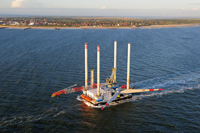|
There is no doubting the success of TETRA as a digital multi-agency communications system which provides land-based first responders and other users with a medium through which to co-ordinate their operations. In Europe, TETRA crosses borders governed by the Schengen agreement on open borders, which spans 25 countries and a population of over 400 million people. Part of that agreement was a requirement for a pan-European, cross-border communications system that could be used by the police and emergency services. Today, forces with coastal regions to police and patrol are increasingly turning to TETRA to provide a feature-rich digital communications capability offshore. Non-emergency users with offshore activities, such as energy companies and ferry operators, are also adopting the technology to support their operations. Rules of the seaBut the rules of the sea in relation to communications are steadfast, and technologies relied upon for generations to ensure the safety of inshore and deep-sea vessels are in no danger of being usurped. On water, TETRA is merely a complementary solution to enhance the operations and mission-critical applications of a wide range of users who have business to do at sea. Maritime industry consultant Paul Eastaugh explained that the SOLAS (Safety of Life at Sea) requirements, as mandated by the International Maritime Organization, include Global Maritime Distress Safety System (GMDSS) equipment and typically include an Inmarsat satcoms link/terminal, a VHF radio capable of digital selective calling (DSC) and GPS solutions. “GMDSS came into force in 1987 to provide a means of global communication that also replaced morse code”, he said. “Ships above 300 tons on international voyages require a full GMDSS suite to comply with these requirements, while smaller ships and inshore craft such as ribs [rigid inflatable boats] and lifeboats have freedom of choice. “Requirements to carry specific radio equipment on non-SOLAS vessels are less dependent on a vessel’s tonnage than they are on its area and type of operation. These craft can, effectively, carry whatever they like, although the globally-accepted standard is certainly to have VHF, which nowadays will preferably be equipped with DSC. “If any such craft choose to adopt any other form of communications, like TETRA, it’s up to them.” With VHF as a maritime fact of life, interoperability with any new communications installation or equipment is crucial. Phil Kidner, chief executive of the TETRA Association, reports that TETRA has now been interfaced with maritime VHF in a number of circumstances, both operationally and in trials. And while there will ‘always’ be a need for maritime VHF – “That’s a given”, he said – if a user needs or wants to add TETRA to its communications capabilities, gateways are available to enable both to interoperate. But with radio there is usually a need for frequency licensing. “TETRA systems at sea very often replace traditional IP DECT systems in order to provide ordinary telephone calls internally, as well as ship-to-shore”, said Svein Damre, vice president of the radio systems supplier Zenitel Norway. “Frequencies for international use are not yet defined and approved for TETRA systems, thus leaving the responsibility for any interference with other systems to the individual ships’ captains. “TETRA systems, however, provide more reliable operation and make coverage within metal ‘constructions’ on ships easier to obtain. User terminals are available in a very wide range including mobile, handheld and ATEX terminals with and without interface for headsets and key switches for PTT operation. Zenitel has developed its own PTT switch for ATEX radios fitting with a Peltor headset. “As for infrastructure”, he continued, “the TETRA infrastructure to be used on ships needs to operate on 24V/48V and must be robust in situations where voltage drops and power failures may occur. Further, the size of the systems supplied must be designed for rack mounting with limited space available. Systems must also be humidity and vibration resistant.” Zenitel makes specific references in its literature to the fact that “TETRA does not have a universal radio spectrum for marine usage. Each installation will require a case by case approval for frequency licensing. It is the ship owner’s responsibility for obtaining the frequency license from the port authority”. Coastal missionsA view of current use of TETRA in coastal applications around the world is provided by two of Motorola’s TETRA team, Raúl Carpio and Bjørn Rasmussen.
|

 For emergency services and users such as public transport operators who conduct their activities in coastal regions,
For emergency services and users such as public transport operators who conduct their activities in coastal regions,